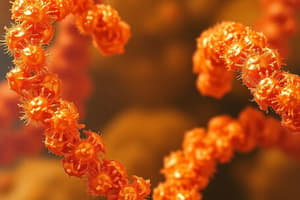Podcast
Questions and Answers
What is the significance of Kozak sequence in translation initiation?
What is the significance of Kozak sequence in translation initiation?
- It helps in termination of translation
- It helps in recognition of start codon
- It increases the rate of translation elongation
- It allows internal initiation of translation (correct)
Why do some codons have a higher chance of being translated more efficiently than others?
Why do some codons have a higher chance of being translated more efficiently than others?
- Due to the abundance of tRNAs for each codon (correct)
- Due to the presence of a selenocysteine codon
- Due to the size of the amino acid being translated
- Due to the presence of a stop codon
What can sometimes be read instead of a stop codon?
What can sometimes be read instead of a stop codon?
- A pyrrolysine codon
- A methionine codon
- A selenocysteine codon (correct)
- A histidine codon
What is the function of the GCN4 protein?
What is the function of the GCN4 protein?
What is the role of the 5'UTR in translation?
What is the role of the 5'UTR in translation?
What is the significance of the sequence context in translation?
What is the significance of the sequence context in translation?
What is the effect of eIF2 inactivation on translation?
What is the effect of eIF2 inactivation on translation?
What is the function of the first uORF in the GCN4 mRNA?
What is the function of the first uORF in the GCN4 mRNA?
Why is GCN4 protein not translated when there is an abundance of amino acids in the cell?
Why is GCN4 protein not translated when there is an abundance of amino acids in the cell?
What determines the regulation of GCN4 translation in response to amino acid availability?
What determines the regulation of GCN4 translation in response to amino acid availability?
What is the purpose of uORFs in some genes?
What is the purpose of uORFs in some genes?
What is the outcome when a ribosome reaches a non-permissive termination sequence in a uORF?
What is the outcome when a ribosome reaches a non-permissive termination sequence in a uORF?
What is the primary effect of uORFs on the translation of downstream reading frames?
What is the primary effect of uORFs on the translation of downstream reading frames?
What is the purpose of the Kozak sequence in the regulation of translation initiation?
What is the purpose of the Kozak sequence in the regulation of translation initiation?
How can the cell regulate the translation of a protein by using alternative translation initiation sites?
How can the cell regulate the translation of a protein by using alternative translation initiation sites?
What is the role of the 5’-UTR region in the regulation of translation?
What is the role of the 5’-UTR region in the regulation of translation?
What is the effect of the presence of a polyA tail on the translation of an mRNA?
What is the effect of the presence of a polyA tail on the translation of an mRNA?
How does the autogenous regulation of translation work in the case of tubulin?
How does the autogenous regulation of translation work in the case of tubulin?
What is the role of the 3’-UTR region in the regulation of translation?
What is the role of the 3’-UTR region in the regulation of translation?
What happens to the translation of an mRNA when the polyA tail is shortened?
What happens to the translation of an mRNA when the polyA tail is shortened?
What is the primary function of microtubules in mRNA trafficking?
What is the primary function of microtubules in mRNA trafficking?
What is the primary role of RNA localization elements?
What is the primary role of RNA localization elements?
What is the primary function of RNA-binding proteins in mRNA trafficking?
What is the primary function of RNA-binding proteins in mRNA trafficking?
In which cellular region are mRNAs localized in neurons?
In which cellular region are mRNAs localized in neurons?
What is the primary function of kinesin in mRNA trafficking?
What is the primary function of kinesin in mRNA trafficking?
What is the primary role of heterogeneous nuclear ribonucleoproteins (hnRNPs) in mRNA trafficking?
What is the primary role of heterogeneous nuclear ribonucleoproteins (hnRNPs) in mRNA trafficking?
Flashcards are hidden until you start studying
Study Notes
Influence of mRNA Sequence on the 3 Stages of Translation
- The formation of the initiation complex CAP depends on the Kozak sequence, and IRES sequences can allow for internal initiations.
- The 5'UTR sequence influences translation, and the scanning of the initiation sequence depends on the Kozak sequence.
Elongation Stage
- Ribosomes do not read all triplets with the same ease, and there is a bias in the use of codons, making some easier to read than others due to the abundance of tRNAs for each codon.
- Slipping sequences can change the reading pattern, and even the presence of a bulky amino acid can hinder the exit of the peptide through the ribosomal channel.
Termination Stage
- The stop triplet can sometimes be read as selenocysteine or pyrrolysine, and there are stops that allow the small subunit to remain on the mRNA and reach later reading patterns.
Regulation of Translation at the mRNA Level
5.1 Regulation with Implication of 5'UTR and ORFs
- The GCN4 gene has a long 5'UTR region and two short ORFs that code for peptides without function, which trap ribosomes that have started translation from the CAP and are located before the sequence that codes for GCN4.
- The first uORF terminates in a permissive termination, and the second uORF4 terminates in a non-permissive termination.
Regulation of GCN4 Translation
- In conditions of sufficient amino acids, eIF2 is active, allowing the ribosome to translate and encounter the first reading pattern (uORF1), which it translates, and upon reaching the stop triplet, it encounters a permissive termination, causing the large subunit to dissociate, but the small subunit remains bound to the mRNA.
- The small subunit then reaches the second reading pattern (uORF4), but since the concentration of active eIF2 is high, it has time to bind to the small subunit before it starts reading uORF4, allowing the complete ribosome to form and translate uORF4.
- In conditions of amino acid scarcity, the concentration of active eIF2 is low, and the small subunit reaches the first reading pattern (uORF1) and encounters a permissive termination, but since the concentration of active eIF2 is low, the small subunit continues scanning the mRNA and bypasses the non-permissive termination of uORF4, allowing it to reach the GCN4 sequence and translate it.
uORFs and Their Effects on Translation
- uORFs are a trap for ribosomes, making them start translating from the uORF and getting trapped, and never reaching the real coding sequence.
- The presence of a uORF is a regulatory mechanism that determines the translation and/or stability of the mRNA.
5.2 Alternative Translation Initiations
- Regulation of protein quantity in the cell can occur through alternative translation initiations, such as skipping the uORF or using alternative AUGs.
- Alternative ORFs (aORFs) can produce truncated proteins, and the cell can combine alternative translation initiations and produce proteins with variable N-termini.
5.3 5'-UTR: Autogenous Regulation
- The 5'-UTR region has various regulatory elements, such as IRES sequences, uORF sequences, and sequences that form structures recognizable by proteins related to translation regulation.
- There are autogenous regulatory mechanisms, similar to those in prokaryotes, that control the translation of certain proteins based on whether they are in excess or deficiency.
5.4 3'-UTR: Activation via PABP
- The 3'-UTR region has structures recognizable by proteins related to mRNA stability, and binding sites for miRNAs, which can regulate translation initiation.
- The polyA tail in the 3'-UTR stimulates translation by being a binding site for PABP, which is an stimulator of the formation of the cap-binding complex, making it easier to initiate translation.
Studying That Suits You
Use AI to generate personalized quizzes and flashcards to suit your learning preferences.



